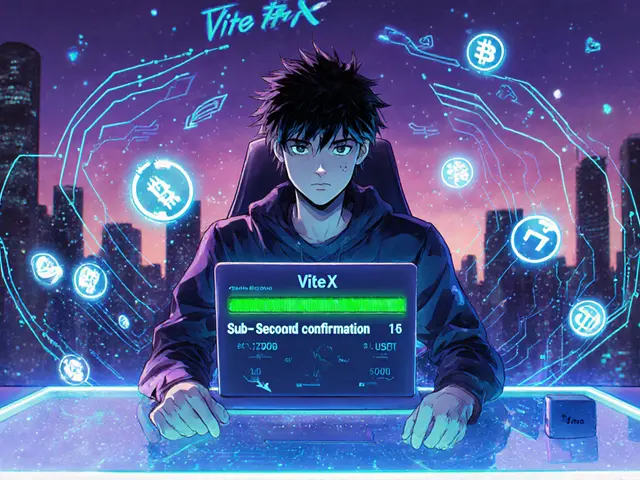ViteX Trading Fee Calculator
ViteX (Current)
Flat 0.20% fee
Sub-second confirmation
No gas fees
Traditional DEX (Example)
0.30% fee + Gas fees ($2-$5)
~12-15 seconds
Gas fees apply
Savings Analysis
ViteX Cost
$0.00
Traditional DEX Cost
$0.00
You save: $0.00
When you’re hunting for a crypto platform that can match the speed of a centralized exchange without the hassle of gas fees, you end up looking at ViteX is a decentralized cryptocurrency exchange (DEX) built on the Vite public blockchain. It promises sub‑second confirmations, a flat 0.20% trading fee and a native VX token that hands out dividends to stakers. This ViteX crypto exchange review breaks down exactly how it works, who benefits, and where it still falls short.
Quick Take
- Sub‑second transaction confirmations thanks to DAG‑based Vite blockchain.
- No gas fees - you only pay the 0.20% maker/taker fee.
- Only four trading pairs (VITE, BTC, ETH, USDT) - limited selection.
- VX token holders earn automatic dividends after staking a minimum of 10 VX.
- Support is community‑driven; no dedicated phone or email help desk.
What Is ViteX?
ViteX is a fully on‑chain decentralized exchange that runs as a dApp on the Vite blockchain. The network uses a directed acyclic graph (DAG) ledger and an asynchronous architecture, which let it confirm trades in under one second - a speed that rivals many centralized platforms.
Because ViteX stores private keys locally in the user’s browser or app, you stay in full control of your funds. The platform’s smart contracts handle everything from order matching to dividend distribution, keeping the system trustless while still delivering a polished UI for both beginners and seasoned traders.
How Does ViteX Work?
Three technical pillars set ViteX apart:
- DAG‑based ledger: Unlike traditional blockchains that add blocks linearly, Vite’s DAG allows multiple transactions to be processed in parallel. This design eliminates the bottleneck that causes high latency on many networks.
- Asynchronous order matching: Orders are matched on‑chain in real time, meaning you see your trade execute almost instantly without waiting for a separate off‑chain engine.
- No gas fees: ViteX absorbs the network‑level cost by using Vite’s internal credit system. Users only pay the flat 0.20% commission, no matter the size of the trade.
The native VX token powers several ecosystem functions. You can "mine" VX by providing liquidity, staking, market‑making, referrals or listing new assets. Once you hold at least 10 VX in your exchange account, the platform’s smart contracts automatically distribute a portion of the exchange’s fee revenue to you each epoch.
Trading Features & Fees
At the moment ViteX supports only four trading pairs:
- VITE - the native coin of the Vite blockchain.
- BTC - Bitcoin.
- ETH - Ethereum.
- USDT - Tether stablecoin.
All trades are executed as limit orders. Market orders, stop‑loss and other advanced order types are slated for a 2025 Q3 rollout. The flat 0.20% fee applies to both makers and takers, which is competitive compared to most DEXs that charge 0.25%‑0.30% on top of gas.
Beyond trading, ViteX offers a fiat gateway (credit‑card purchases), OTC desk and a launchpad for new token offerings. These services broaden the platform’s appeal beyond pure spot trading.

Pros, Cons & How ViteX Stacks Up
| Feature | ViteX | Uniswap (Ethereum) | PancakeSwap (BSC) |
|---|---|---|---|
| Transaction speed | ~0.8 sec (DAG) | ~12‑15 sec (Ethereum) | ~3‑5 sec (BSC) |
| Gas fees | None (absorbed by Vite) | Variable, often $2‑$5 | Low, $0.01‑$0.10 |
| Trading fee | 0.20% flat | 0.30% + gas | 0.25% + gas |
| Trading pairs | 4 (VITE, BTC, ETH, USDT) | Hundreds | Hundreds |
| Advanced order types | Limit only (roadmap Q3 2025) | Limit, market, stop‑loss | Limit, market, stop‑loss |
| Liquidity depth | Moderate - lower than major DEXs | High | High |
| Regulatory oversight | No specific licensing (privacy‑focused) | No licensing (decentralized) | No licensing (decentralized) |
In short, ViteX wins on speed and cost, but loses on pair variety and advanced trading tools. If you prioritize ultra‑fast, fee‑free swaps and don’t need a huge selection of tokens, ViteX can feel like a breath of fresh air.
User Experience & Community Support
The UI is clean and responsive on desktop, mobile web, and native apps. Newcomers appreciate the straightforward layout - the “Buy” button, the order‑book view, and a one‑click “Stake VX” widget. Because private keys never leave the client, security‑focused users feel comfortable.
Support, however, is primarily community‑driven. The official Discord, Telegram groups and a knowledge base are the main channels. There’s no dedicated ticket system, so response times can vary from a few minutes (active community) to several hours (off‑peak). For traders who need 24/7 live help, this could be a deal‑breaker.
Regulatory & Safety Considerations
ViteX operates without a formal license, which brings both freedom and risk. Users retain full custody of their assets, meaning there’s no custodial protection if something goes wrong. The lack of jurisdiction also means the platform blocks U.S. IP addresses to avoid conflict with U.S. securities laws.
On the safety side, the platform leverages smart contracts that have been audited by third‑party firms (audit reports published on the ViteX website). Nonetheless, any bug in the contract could expose funds. Users should only allocate what they can afford to lose and consider using hardware wallets for large balances.
Is ViteX Right for You?
Here are three typical scenarios:
- Speed‑focused traders: If you trade small‑to‑medium sized orders and hate waiting for confirmations, ViteX’s sub‑second speed is a clear advantage.
- Cost‑conscious investors: The zero‑gas model plus a 0.20% flat fee makes it ideal for frequent swapping, especially when moving between BTC, ETH, and USDT.
- Advanced strategy seekers: If you need margin, futures, or a deep pool of altcoins, you’ll hit a wall until ViteX expands its feature set later this year.
Bottom line: Treat ViteX as a niche DEX that excels in performance and cost, but complement it with a larger DEX or a centralized exchange for broader market access.
Frequently Asked Questions
Does ViteX really have zero gas fees?
Yes. ViteX uses the Vite blockchain’s internal credit system, so users only pay the 0.20% trading fee. No separate network‑level gas is charged.
What is the VX token and how do I earn it?
VX is ViteX’s native utility token. You can acquire VX by providing liquidity, staking VITE, acting as a market‑maker, referring new users, or having a token listed on ViteX. Staking a minimum of 10 VX unlocks dividend payouts from the exchange’s fee revenue.
Can I trade on ViteX from the United States?
No. ViteX blocks IP addresses from the U.S. to stay clear of local securities regulations. Users outside restricted jurisdictions can access the platform freely.
How does ViteX ensure security of my funds?
Private keys are stored locally in your browser or app, meaning you control the keys at all times. The platform’s smart contracts have undergone third‑party audits, but nothing is 100% risk‑free; use a hardware wallet for large amounts.
What new features are planned for 2025?
ViteX’s roadmap lists market orders, stop‑loss orders, and a broader set of trading pairs for Q3 2025. The team also aims to improve customer support channels and explore regulatory compliance for broader market access.











Comments (16)
MARLIN RIVERA
March 19, 2025 AT 16:56 PMThe fee structure looks slick on paper, but the hidden costs in liquidity provision will bite you later. Users should dig deeper before trusting the hype.
Nathan Blades
March 19, 2025 AT 18:19 PMViteX markets itself as a frictionless DEX, promising sub‑second confirmations and zero gas fees.
The flat 0.20 % fee is certainly lower than the 0.30 % plus gas fees on many competitors, yet it does not account for the price impact of thin order books.
While those numbers are impressive, the reality of order book depth on a relatively new platform remains uncertain.
Traders accustomed to the deep liquidity of major exchanges may find slippage creeping in during volatile periods.
The platform’s reliance on Vite’s native blockchain introduces a dependency on its validator set, which could affect network resilience.
From a security standpoint, ViteX has undergone several audits, but the codebase is still evolving, and past bugs in similar projects have shown how quickly trust can erode.
Users should also be aware that the convenience of ‘no gas’ is achieved by bundling transactions, which may delay settlement under heavy load.
The user interface feels polished, but the fee calculator widget appears to be a static example rather than a live estimator.
For high‑frequency traders, the reported sub‑second confirmation time could be a game‑changer, provided the infrastructure scales.
However, the lack of a robust market‑making incentive program may discourage liquidity providers from committing capital.
In practice, many DEXs rely on external incentives to bootstrap volume, and ViteX’s current model is still nascent.
If you are a casual trader moving modest sums, the fee savings might outweigh the potential liquidity concerns.
Institutional players, on the other hand, will likely run extensive simulations before allocating assets to a platform with limited track record.
Proceed with a modest pilot trade, monitor the order book spread, and adjust your exposure accordingly.
Somesh Nikam
March 19, 2025 AT 21:06 PMGreat to see a DEX that actually cares about user costs – no gas, flat fees, and a clean UI. It feels like the team listened to community feedback :)
Jan B.
March 20, 2025 AT 01:16 AMLooks promising but we need more data on volume and slippage.
Debby Haime
March 20, 2025 AT 06:49 AMI’m excited about the speed claims, especially for traders looking to capitalize on rapid price movements. The fee savings alone could make a difference for daily swing traders, and the absence of gas fees lowers the barrier for newcomers. Still, keep an eye on the liquidity pools – without depth, those sub‑second confirmations won’t matter much when you’re stuck with bad fills.
Andy Cox
March 20, 2025 AT 13:46 PMCool concept, will watch how it grows.
Courtney Winq-Microblading
March 20, 2025 AT 22:06 PMThe philosophical side of trading on a truly fee‑free platform is fascinating – it nudges us toward thinking of value creation rather than cost avoidance. Yet, as any seasoned thinker will tell you, the market’s invisible hand still imposes hidden taxes in the form of spreads and opportunity costs.
Richard Herman
March 21, 2025 AT 09:12 AMViteX seems to bridge the gap between centralized speed and decentralized freedom. If the community can rally enough liquidity, this could become a real alternative to the big players.
Parker Dixon
March 21, 2025 AT 20:19 PMAbsolutely love the idea of zero gas – it removes a huge pain point for many. 🎉 The flat fee is also a breath of fresh air compared to the typical 0.3 % plus hidden costs. Just remember to test with a small amount first to see how the order book behaves under real market pressure. 🚀
Stefano Benny
March 22, 2025 AT 08:49 AMHonestly, the hype feels like a classic DeFi FOMO cycle – low fees, high speed, but the underlying liquidity infrastructure is still a white‑paper exercise.
Evie View
March 22, 2025 AT 22:42 PMThis so‑called "fee‑free" DEX is just another way for the devs to siphon value under the guise of speed. Don't let the marketing fluff blind you.
Sidharth Praveen
March 23, 2025 AT 13:59 PMOptimistic vibes about ViteX are understandable – lower fees can really help small traders build up capital. That said, I’d advise a cautious approach: start with micro‑trades, monitor how quickly orders fill, and keep an eye on any sudden spikes in transaction latency.
Sophie Sturdevant
March 24, 2025 AT 06:39 AMFrom a technical standpoint, the architecture looks sound, but the real test will be the incentive mechanisms for market makers. Without robust LP rewards, the platform may struggle to maintain tight spreads over time.
emmanuel omari
March 25, 2025 AT 00:42 AMViteX is just another showcase for the Vite blockchain’s propaganda – don’t be fooled by the marketing.
katie littlewood
March 25, 2025 AT 20:09 PMHaving taken a few stabs at ViteX over the past month, I can attest that the UI is undeniably slick; the navigation feels intuitive, and the speed promises translate into real‑time order confirmations most of the time. Yet, there’s an undercurrent of uncertainty regarding depth – I’ve observed occasional thin order books on less popular pairs, leading to notable slippage that can erode those fee savings. Moreover, the platform’s community engagement is growing, with several Discord channels buzzing about liquidity mining initiatives, but the details remain embryonic, and without clear incentives, seasoned liquidity providers remain hesitant. On the security front, the audit reports are publicly available and appear thorough, but the real‑world resilience of the network under heavy load still needs validation. In practice, for everyday traders moving moderate volumes, ViteX offers a compelling alternative to the traditional DEX fare, especially when you factor in the absence of gas fees that can otherwise balloon on congested networks. In contrast, institutional actors should probably conduct a more rigorous stress test before committing substantial capital. All in all, ViteX shines brightest as a low‑cost, fast‑execution playground for retail traders, while still having some growing pains to address as it scales.
Jenae Lawler
March 26, 2025 AT 15:36 PMWhilst the discourse surrounding ViteX is replete with laudatory proclamations, a scrupulous examination reveals that its purported fee‑exempt paradigm may merely constitute a veneer, concealing the latent costs inherent in market impact and the paucity of liquidity depth. Accordingly, one ought to approach such platforms with a judicious blend of optimism and circumspection.